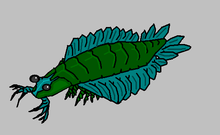Parapeytoia
| Parapeytoia Temporal range: Cambrian Stage 3 | |
|---|---|
 | |
| Scientific classification | |
| Kingdom: | Animalia |
| Class: | †Dinocaridida |
| Order: | †Radiodonta |
| Family: | †Anomalocarididae (?) |
| Genus: | †Parapeytoia Hou, Bergstrom & Ahlberg, 1995 |
| Binomial name | |
| Parapeytoia yunnanensis Hou, Bergstrom & Ahlberg, 1995 | |
Parapeytoia was a prehistoric animal that lived over 530 million years ago that lived in Maotianshan shales of prehistoric China. Like the anomalocarids that it resembled (or was possibly related to), Parapeytoia had two head appendages in front of the also anomalocarid like round mouth, eyes on stalks, and a fleshy-lobed posterior with a fan tail. Parapeytoia had at least 14 pairs of lobes on the sides of the body.
Many scientists debate whether or not Parapeytoia was a true anomalocarid, or rather more closely related to Yohoia or Haikoucaris, because unlike anomalocarids such as Amplectobelua, it had legs. In total, Parapeytoia had 13 pairs of legs. Its first two pairs of legs were usually half the length of the remaining ones. Since it had legs, Parapeytoia was in all likelihood a benthic feeder, spending most of its time on the ocean floor hunting (or possibly scavenging) for prey.
The food for Parapeytoia probably included arthropods (including trilobites), worms, early molluscs and other creatures found in the diversity of prehistoric China.
Sclerites interpreted as its mouthparts have since been assigned to a new priapulid worm genus, Omnidens.[1]
References
- ↑ Hou, Xianguang; Bergström, Jan; Jie, Yang (2006). "Distinguishing anomalocaridids from arthropods and priapulids". Geological Journal. 41 (3–4): 259–269. doi:10.1002/gj.1050.
- Dinocaridids: anomalous arthropods or arthropod-like worms? by Hou Xianguang & Jan Bergström 2006 arguing that this genus is a dinocaridid